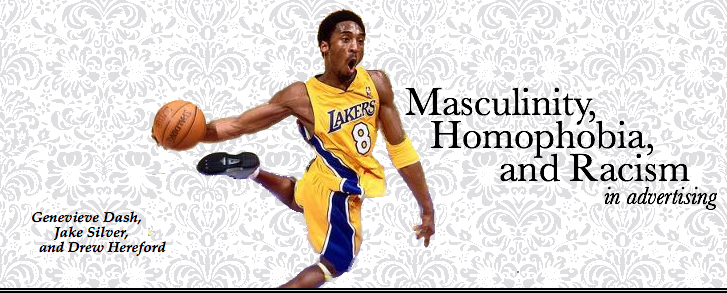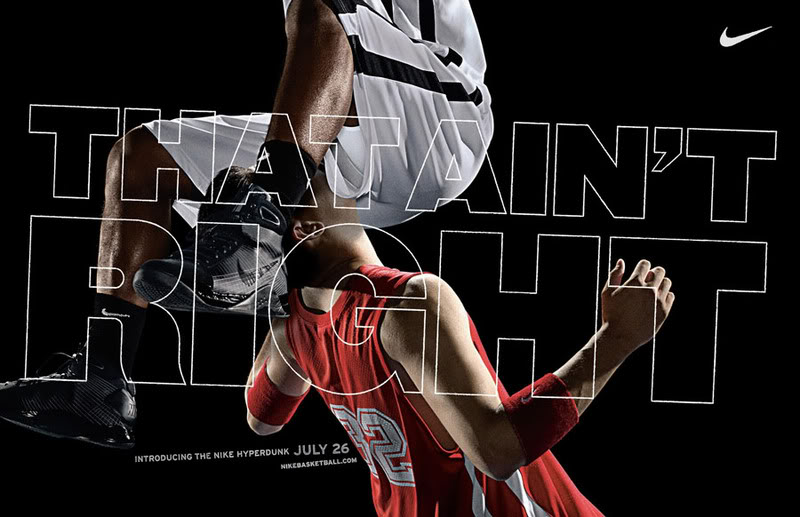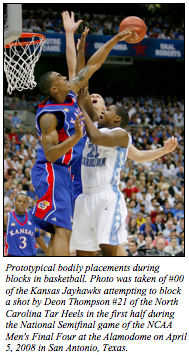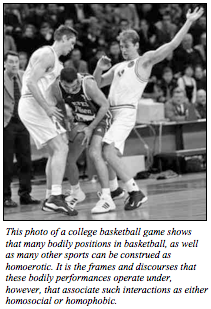
|
When first viewing
ads, the eye searches for prominent focal points, but also reverses its
concerted gaze and takes in the entire piece as a whole. The question
thus immediately arises within Nike’s most controversial ad
for their 2008 Hyperdunk campaign: what ideas, images, and
significations become intertwined within the advertising medium? What
are the discursive elements of the advertisement and how are they in a
dialogue with one another as well as culture at large? There are three main solitary visual elements that serve to create a divide between the two players depicted within Nike's "That Ain't Right" ad, as well as other ads in the campaign: color contrasts, illuminations, and positions. The colors of the players’ jerseys explicitly attract the eye: the sheer white of the player performatively ‘dunking’ contrasts the black background, while the redness of the player performatively getting ‘dunked on’ stands out as the only color source of the print that is not black or white. Moreover, light originates from both the back right and the left in the ad, which illuminates both players and evokes a dueling battle for the ad’s focal point. The shoe, as the advertised product, seems to have barely any command in the image, for the black color of the shoe falls flat compared to the aforementioned elements of light, color, and the central positioning of the two players in the ad. Instead of broadcasting qualities of the Hyperdunk, this advertisement has effectively framed a battle scene between two players. We are then confronted with a divisive question when the eye focuses
“The fear of
emasculation by other men, of being humiliated,
of being seen as a sissy, is the leitmotif…of the history of
American manhood. Masculinity has become a relentless test
by which we
prove to other men, to women, and ultimately to ourselves, that we have
successfully mastered the part” (1994:138).
Homophobia in Kimmel’s theory encapsulates not a hatred of gay men, but a fear of being socially categorized as 'gay' or 'sissy,' which acts within male-to-male power relations as the impetus for performing a perceived paragon of masculinity. Kimmel’s ideas materialize through the intersection of sexual and masculinized power relations within this ad. The success of the ‘dunking’ player and humiliation of the player getting ‘dunked on’ can
With such a literal power relationship within the ad, the phrase, “That Ain’t Right,” becomes a classificatory warning, essentially making this ad one of didactic force. This title denigrates the subject matter of the ad, which, as previously noted, is the perceived homosexuality through the illuminated image of the emasculated player. The implicated homophobia of the image is more so indicated by the jersey of the ‘homosexual’ player being the only colored item of the ad, and thus framing the embodiment of this player as the “other.” The agency of this player becomes labeled as opposing the success of the dominant player, as 'not right,' incorrect, and unsavory. Although one may think shoes should be at the center of this advertisement, the elements of the ad so clearly divide hegemonic power in masculinity between these two players that the scene becomes an intersection of reified masculinity (within the dominant player) and the homosexual as represented through the passivity and inability to act of the other player. Power becomes appropriated within the ad, and thus the helplessness of the emasculated player embodies a cultural logic that condemns homosexuality and rather places social power within the image of the domineering, masculine male. |
|||||||||
"Punks Jump Up" // Further Information // Sexism and Racism in Advertising Homepage

